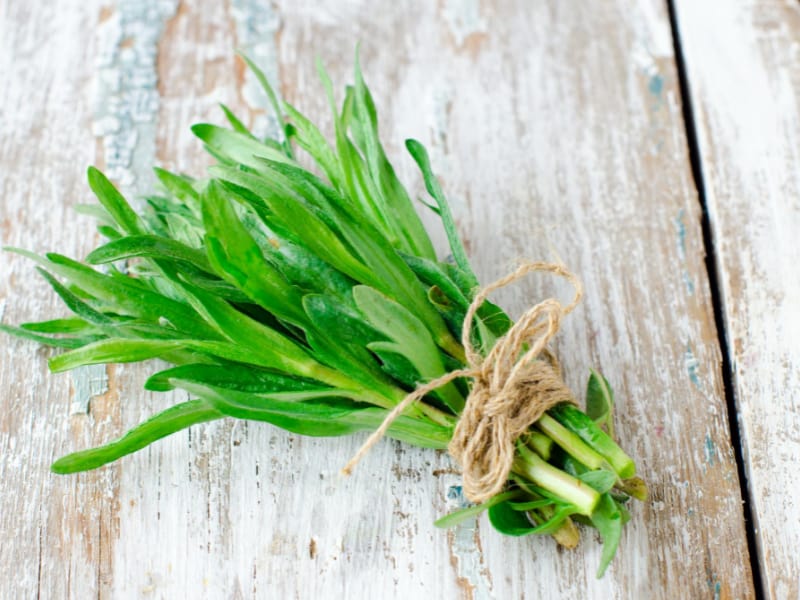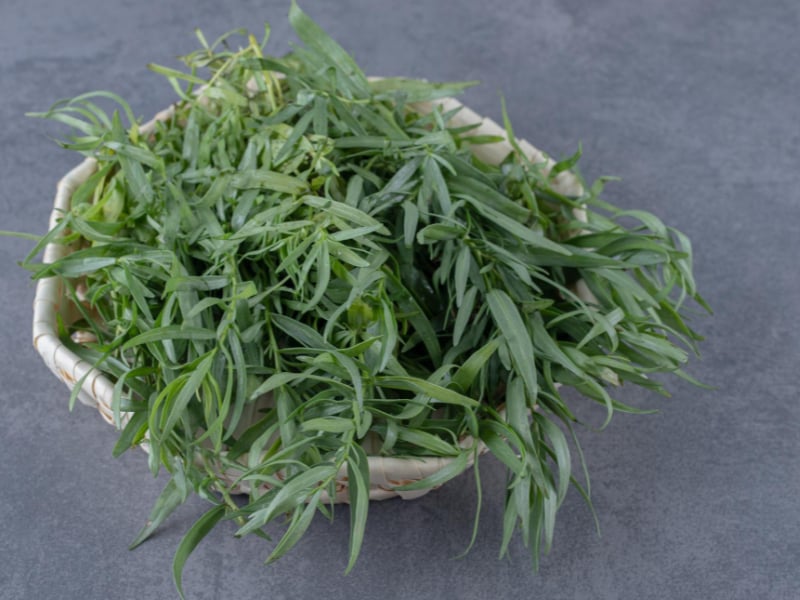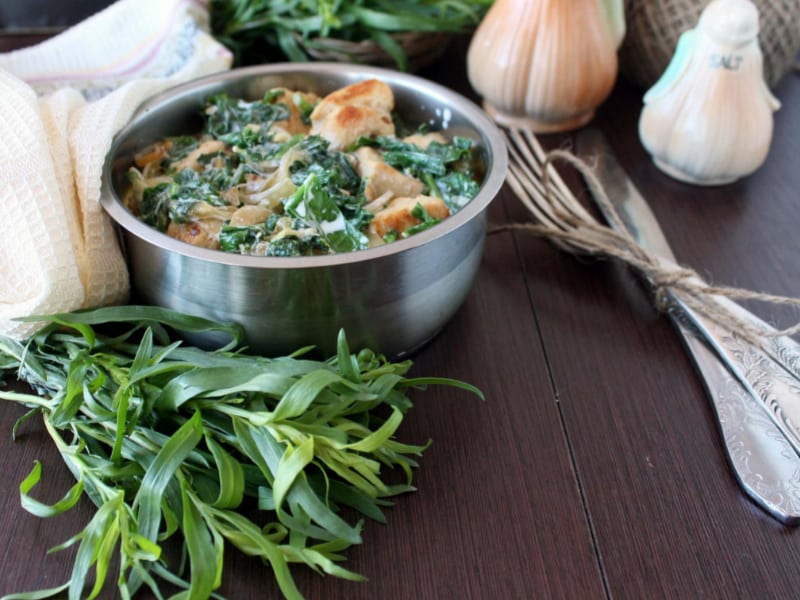Do you love tarragon? It’s a great herb to add to salads, soups, sauces, and even desserts. But do you know how to grow tarragon?
Do you know what the best tarragon companion plants are?
It’s important to think about the companion plants that you grow next to the tarragon plant. The right companions will help your tarragon thrive.
This article will cover more about growing tarragon, companion plants, and how to help them and your overall garden grow better together.

What is Companion Plant Gardening?
Companion planting has been a traditional method of crop production for centuries. One of the first known instances of companion planting is found in the Native American culture.
8-10,000 years ago, many of the Native tribes in America planted squash, beans, and corn together, calling them the Three Sisters.
The way the Three Sisters were grown together is the perfect example of companion planting. The corn was planted first and grown to support the climbing beans. The beans bring and fix nitrogen into the soil, which benefits the two other plants.
The squash provides a living mulch, shading the ground to keep it cool, moist, and weed-free. The prickly vines and leaves of the squash also deter pests.
Today, there has been a resurgence of companion planting as a reaction against industrial farming methods that can damage the ecosystem.
Smaller farms are embracing the variety of crops that comes with companion planting, and farmers feel more secure knowing that if one crop fails, they have others to fall back on.
Other benefits of companion planting include:
- Biodiversity that encourages beneficial pollinators and insects
- Natural soil enrichment
- Natural pest control
These benefits lead to less need for chemical fertilizers, pesticides, and herbicides, which can strip the soil and leach into the water table.
Many herbs and flowers are especially useful for their insect repelling properties and their ability to attract pollinators to the garden.
What is Tarragon?
Tarragon is an aromatic herb with a licorice flavor. This culinary herb has glossy green leaves and is often used by the French in a multitude of dishes, which is why they have dubbed it the “King of Herbs.”
Tarragon is a perennial herb, which means it will die back over the winter and re-grow in the spring. There are a number of different varieties of Tarragon, including Spanish, Russian, and Mexican Mint; however, French Tarragon is the most common.
A member of the Asteraceae family, it is related to sunflowers, lettuce, and artichokes.
Tarragon are propated through root division or stem cuttings in the spring.
The French use tarragon in Bearnaise sauce, but tarragon also goes well with chicken, fish, and eggs. It is also used in salad dressings and sauces.
The overriding flavor of tarragon is licorice, but it also has hints of vanilla, mint, and pepper, giving it a complex flavor – which is not to everyone’s taste. However, even if you are not fond of the flavor, you might want to consider growing it as it makes an excellent companion plant.

Why Is Tarragon a Good Companion Plant?
Many gardeners make tarragon an essential part of their garden due to its multiple benefits as a companion plant.
Tarragon can act as a “nursing plant” to the surrounding plants. It can improve the growth and health of nearby plants and makes many edible crops more flavorful. Tarragon is also thought to increase the yield of many herbs and vegetables.
Tarragon acts as a natural pest control as it repels aphids, whitefly, mosquitoes, and hornworms. This trait makes it a great plant for your vegetable garden or greenhouse.
As tarragon will enhance the properties of surrounding plants, you can also plant it with other herbs to increase their insect repellent properties.
Plants like dill, can repel cabbage loopers and spider mites, while attracting beneficial insects like bees and butterflies, are great in combination with tarragon. Other insect-repelling herbs like chives and mustard greens will also be enhanced when planted alongside tarragon.
While tarragon can be grown anywhere in the garden, it prefers soil that is not too damp, but not dry soil either. Be careful of overwatered soil because that can lead to powdery mildew and root rot. It does like heat, but it can tolerate partial shade.
What Herbs Can Be Planted With Tarragon?
The best herbs to plant with tarragon are other Mediterranean perennials, as they will like similar soil. Oregano, rosemary, marjoram, and dill are among some of the herbs to best grow with tarragon to create a Mediterranean herb garden.
Despite liking a drier sandier soil, tarragon can also be grown with moisture-loving herbs like parsley and basil. Lemon-scented herbs can also benefit from being grown near tarragon, as will chives and cilantro.
Chives, garlic, and cilantro are great companion plants for tarragon, as they can ward off spider mites that are the only insects that will attack tarragon leaves. As these herbs like the same soil conditions and climate, they are perfect for planting together.
Planting tarragon plus herbs that repel spider mites in your vegetable patch will make a winning combination for natural pest control.
Some gardeners will recommend avoiding growing rosemary and tarragon in the same soil, as rosemary likes drier soil, while tarragon tends to thrive in semi-moist soil. However, you can always use a spiral herb garden if you want to grow different herbs in the same place.
Oregano is another fresh herb that might not go as well with tarragon as some others. Its tendency to spread can be detrimental to tarragon, and you may find that you have a job pulling out the spreading oregano to make room for tarragon.

Can You Plant Tarragon With Vegetables?
Tarragon is one of the most perfect plants to use as a companion for vegetables. Its insect repelling properties will help keep those pesky pests away from your crop, but it has other benefits too.
Like herbs, the flavor of vegetables can be enhanced by having tarragon as a companion plant. Vegetables that will thrive next to tarragon include eggplant, zucchini, carrots, squash, tomatoes, and broccoli.
Tarragon is an especially good companion for eggplants. Garden pests are often drawn to eggplant, and you may find your beautiful purple fruit has been eaten away on the underside when you pick it.
The odor of tarragon will drive away pests that munch on your eggplant, and it is believed that tarragon will also increase the flavor of the vegetable as well as the yield of the plant.
Can You Plant Tarragon With Fruit?
While tarragon is normally used as a companion plant to vegetables, soft fruit can also benefit.
Strawberries, in particular, will have their flavor improved and produce more fruit when planted with tarragon. Strawberries will also benefit from tarragon’s insect repelling properties.
Tarragon Companion Plants Final Thoughts
Tarragon is a wonderful herb and companion plant to a variety of gardens. It is easy to grow, and its attractive foliage makes it a welcome addition to many other plants.
You may also be interested in these other articles:


I used herbs a lot for my health